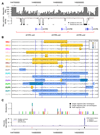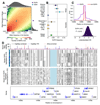Resistance to malaria through structural variation of red blood cell invasion receptors
- PMID: 28522690
- PMCID: PMC5575826
- DOI: 10.1126/science.aam6393
Resistance to malaria through structural variation of red blood cell invasion receptors
Abstract
The malaria parasite Plasmodium falciparum invades human red blood cells by a series of interactions between host and parasite surface proteins. By analyzing genome sequence data from human populations, including 1269 individuals from sub-Saharan Africa, we identify a diverse array of large copy-number variants affecting the host invasion receptor genes GYPA and GYPB We find that a nearby association with severe malaria is explained by a complex structural rearrangement involving the loss of GYPB and gain of two GYPB-A hybrid genes, which encode a serologically distinct blood group antigen known as Dantu. This variant reduces the risk of severe malaria by 40% and has recently increased in frequency in parts of Kenya, yet it appears to be absent from west Africa. These findings link structural variation of red blood cell invasion receptors with natural resistance to severe malaria.
Copyright © 2017, American Association for the Advancement of Science.
Figures






Comment in
-
Glycophorin alleles link to malaria protection.Science. 2017 Jun 16;356(6343):1122-1123. doi: 10.1126/science.aan4184. Science. 2017. PMID: 28619899 No abstract available.
References
-
- Miller LH, Baruch DI, Marsh K, Doumbo OK. The pathogenic basis of malaria. Nature. 2002;415:673–679. - PubMed
-
- World Health Organization. World Malaria Report. 2015
-
- Cowman AF, Crabb BS. Invasion of red blood cells by malaria parasites. Cell. 2006;124:755–766. - PubMed
-
- Langhi DM, Jr, Bordin JO. Duffy blood group and malaria. Hematology. 2006;11:389–398. - PubMed
-
- Gaur D, Mayer DC, Miller LH. Parasite ligand-host receptor interactions during invasion of erythrocytes by Plasmodium merozoites. Int J Parasitol. 2004;34:1413–1429. - PubMed

